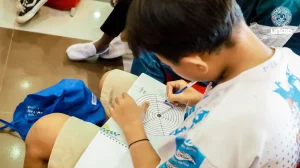Surabaya City has a water reservoir system that has the same function as a reservoir called bozem. There are some bozem in Surabaya, such as Bozem Moro Krembangan, Kalidami, Bratang, Rungkut Industri, Wonorejo, Kedurus, and Jurang Kuping. Bozem was built because Surabaya is a city prone to flooding due to lack of water catchment areas.
As we know, development in the city of Surabaya is growing rapidly. It brings an impact with the reduction in water catchment areas. In general, bozem was built without diverting rivers or other public waters. In general, bozem functions to control and store water; however, it can also be used for fish farming and irrigating rice fields.
One of bozem that is used for fish farming is Bozem Moro Krembangan. Fish culture in Bozem Moro Krembangan uses a floating net karamba system, and the type of fish being cultivated is the African catfish (Clarias gariepinus). The bozem as a reservoir of water, both from rivers and from household organic wastewater, ensures fertile waters for the growth of microorganisms such as bacteria and fungi. Considering the function and condition of bozem waters, it is necessary to study whether fish cultivation in bozem waters, especially in Moro Krembangan, is feasible, especially regarding the occurrence of infections of Aeromonas hydrophila and Saprolegnia sp. in the cultivated fish.
The research was conducted to identify Aeromonas hydrophila and Saprolegnia sp., which is a type of bacteria and fungi that cause fish disease to African catfish cultivated in Bozem Moro Krembangan. Fish disease due to bacterial pathogen attack (bacterial disease) is one of the severe problems for catfish farmers because it has the potential to incur loss to fish farmers.
Bacterial disease attacks can result in death of up to 50-100%, and reduce the quality of the fish meat of infected fish due to ulcers or wounds. Thus, consumers will not like it. Aeromonas hydrophila bacteria greatly affect freshwater fish farming business and often cause disease outbreaks with a high mortality rate of 80-100 percent in a short period of 1-2 weeks. The infectious disease caused by fungi and which is quite detrimental to aquaculture activities is Saprolegniasis caused by Saprolegnia sp. It often infects eggs and fresh fish that cause mass death in aquaculture.
Isolation and identification of Aeromonas hydrophila and Saprolegnia sp. were conducted to 20 catfish (Clarias gariepinus) obtained from 2 floating net cages. Isolation of Aeromonas hydrophila used isolation media Trypticase Soy Agar (TSA) and Saboraud Dextrose Agar (SDA) used for the isolation of Saprolegnia sp. The identification used conventional method including the examination of colony morphology, cell morphology, and biochemical tests. As supporting data, several parameters of water quality were measured around floating net cages, including temperature, pH, dissolved oxygen (DO) and ammonia levels.
Isolation of Aeromonas hydrophila and Saprolegnia sp. performed on 20 catfish with clinical symptoms, reddish wounds, flaky flippers and tails, and the presence of fine cotton-like threads on the surface of the catfish’s body. The results of isolation and identification showed 95 percent of catfish infected with Aeromonas hydrophila and 90 percent infected with Saprolegnia sp.
Aeromonas hydrophila is an opportunistic pathogen because it can only cause disease in weak fish populations or as a secondary infection when fish are infected with other diseases. These bacteria attack many catfish and it can infect fish of all sizes and cause death to reach 80 percent. Thus, resulting in enormous losses in the business of freshwater fish farming.
Fungal infection in fish is generally secondary infection that was preceded by bacterial infections, poor aquatic environments, parasitic infestations, high stocking densities, so the catfish (Clarias gariepinus) easily infected with Saprolegnia sp. The water quality measured during this research was, temperature 30 o C, DO 4 mg / l, pH 6-7 and ammonia 1.0 mg / l. These results are still in normal category for fish farming activities, except the ammonite content that must be watched out because it is already within the borderline of tolerance limit.
Based on the results of the study it can be concluded that there was an infection of Aeromonas hydrophila and Saprolegnia sp. in most of the African catfish samples examined. It showed that the cultivation of African catfish in Bozem Moro Krembangan must be conducted with great vigilance to avoid greater losses of fish farmers around bozem. (*)
Author: Rahayu Kusdarwati
The complete research results can be viewed in,
https://iopscience.iop.org/article/10.1088/1755-1315/55/1/012038/pdf









